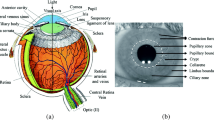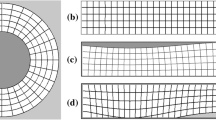Abstract
In an authentic biometric system, iris recognition aims to detect the iris pattern of a person. The single unique pattern of the human iris may be extracted from the image and encoded, such that a given code may be compared to several others, and then validating if the patterns belong to a particular eye or not. Iris localization is an important aspect of iris recognition since accuracy in iris localization affects iris recognition. The previous iris localization methods were less efficient owing to slow processing time and inefficiency in handling non-straight faces in imperfect conditions. In this paper, we propose a new iris localization method with direction and deformation independence. It is based on the idea that the iris is localized from the side face and from distance. A novel approach of curve fitting using polynomial along with singleton expansion is adopted to efficiently and accurately localize the iris in any distance and direction from the camera. We validate the method by experimental analysis on the basis of accuracy, segmentation error and execution time. The method is suggested to be significant for diagnosing several eye-related disorders as well as for biometric authentication processes.














Similar content being viewed by others
References
Abate AF, Frucci M, Galdi C, Riccio D (2015) BIRD: watershed Based IRis Detection for mobile devices. Pattern Recogn Lett 57:43–51
ARROWSNX F-04G (2015). http://www.fujitsu.com/global/about/resources/news/press-releases/2015/0525-01.html/ Accessed 15 October 2016
Ayvali E, Desai JP (2015) Optical Flow-Based Tracking of Needles and Needle-Tip Localization Using Circular Hough Transform in Ultrasound Images. Ann Biomed Eng 43(8):1828–1840
Bharadwaj S, Vatsa M, Singh R (2014) Biometric quality: a review of fingerprint, iris, and face. EURASIP Journal on Image and Video Processing 2014(1):34
Cament LA, Castillo LE, Perez JP, Galdames FJ, Perez CA (2014) Fusion of local normalization and Gabor entropy weighted features for face identification. Pattern Recogn 47(2):568–577
Cao L, Zhou Y, Yan F, Tian Y (2014) A novel iris segmentation approach based on superpixel method. 2014 IEEE International Conference on Instrumentation and Measurement, Computer, Communication and Control (IMCCC) (pp. 826–831)
Chinese Academy of Sciences (2016) CASIA Iris Image Database. Available: http://biometrics.idealtest.org/ (Accessed on Feb. 2016)
Dagnes N et al (2018) Occlusion detection and restoration techniques for 3D face recognition: a literature review. Mach Vis Appl 2018:1–25
Daugman J (1993) High confidence visual recognition of persons by a test of statistical independence. IEEE Transactions on Pattern Analysis and Machine Intelligence (PAMI) 15(11):1148–1161
Dey S, Samanta D (2007) A Novel Approach to Iris Localization for Iris Biometric Processing. International Journal of Biomedical and Biological Engineering 1(5):293–304
Dora L, Agrawal S, Panda R, Abraham A (2017) An evolutionary single Gabor kernel based filter approach to face recognition. Eng Appl Artif Intell 62:286–301
Elrefaei LA, Hamid DH, Bayazed AA, Bushnak SS, Maasher SY (2017) Developing Iris Recognition System for Smartphone Security. Multimedia Tools and Applications, 1–25
ForYourIrisOnly (2013). http://www.iritech.com/products/software/foryouririsonly-iris-recognitionsoftware Accessed 15 october 2016
ForYourIrisOnlyLite (2016). https://play.google.com/store/apps/details?id=com.iritech.fyio.lite&hl=en Accessed October 2016
Frucci M et al (2016) WIRE: watershed based iris recognition. Pattern Recognition, 78–89
Gaikwad PP et al (2017) A Person Identification Framework Based on PalmPrint and Fingerprint Biometrics. Int J Eng Sci 13:176
Galbally J, Marcel S, Fierrez J (2014) Image quality assessment for fake biometric detection: Application to iris, fingerprint, and face recognition. IEEE Trans Image Process 23(2):710–724
Galdia C et al (2016) Multimodal authentication on Smartphones: combining iris and sensor recognition for a double check of user identity. Pattern Recogn Lett 82(2):157–169
Govindaraju V, Koh J, Chaudhary V (2010) A robust iris localization method using an active contour model and Hough transform. International Conference on Pattern Recognition 1–5
Gupta R, Gupta K (2016) Iris recognition using templates fusion with weighted majority voting. International Journal of Image and Data Fusion 7(4):325–338
Gupta R, Kapoor R (2012) Comparison of Graph Based Methods for Non-Linear Dimensionality Reduction. Int J of Signal and Imaging System Engineering, Inderscience 5(2):101–109
Gupta R, Kapoor R (2015) Data Compression by Discrete Wavelet Transform using Matched Wavelet. Int J Signal and Imaging Systems Engineering, Inderscience 8(4):205–214
Hai DT, Son H, Vinh LT (2017) Novel fuzzy clustering scheme for 3D wireless sensor networks. Appl Soft Comput 54:141–149
Haindl M, Krupička M (2015) Unsupervised detection of non-iris occlusions. Pattern Recogn Lett 57:60–65
He Z, Tan T, Sun Z, Qiu X (2009) Toward accurate and fast iris segmentation for iris biometrics. IEEE Trans Pattern Anal Mach Intell 31(9):1670–1684
Hofbauer H, Alonso-Fernandez F, Wild P, Bigun J, Uhl A (2014) A Ground Truth for Iris Segmentation. In: O’Conner L (ed) 2014 22nd International Conference on Pattern Recognition (ICPR). IEEE Computer Society International Conference on Pattern Recognition, Los Alamitos, pp 527–532. https://doi.org/10.1109/ICPR.2014.101
Hollingsworth KP, Bowyer KW, Flynn PJ (2009) The best bits in an iris code. IEEE Trans Pattern Anal Mach Intell 31(6):964–973
Hu Y, Sirlantzis K, Howells G (2015) Improving colour iris segmentation using a model selection technique. Pattern Recogn Lett 57:24–32
Hu Y, Sirlantzis K, Howells G (2016) Iris liveness detection using regional features. Pattern Recogn Lett 82:242–250
Hu Y, Sirlantzis K, Howells G (2017) A novel iris weight map method for less constrained iris recognition based on bit stability and discriminability. Image Vis Comput 58:168–180
Jan F (2018) Pupil localization in image data acquired with near-infrared or visible wavelength illumination. Multimed Tools Appl 77(1):1041–1067
Jillela RR, Ross A (2015) Segmenting iris images in the visible spectrum with applications in mobile biometrics. Pattern Recogn Lett 57:4–16
Kang BJ, Park KR (2007) Real-time image restoration for iris recognition systems. IEEE Transactions on Systems, Man, and Cybernetics, Part B (Cybernetics) 37(6):1555–1566
Kapoor R, Gupta R (2013) Non-Linear Dimensionality Reduction using Fuzzy Lattices. Computer Vision, IET 7(3):201–208
Kapoor R, Gupta R (2015) Morphological Mapping for Non-linear Dimensionality Reduction. Technique Computer Vision, IET 9(2):226–233
Kaur H, Sohal J (2017) Iris localization using hybrid algorithm containing circular Hough transform, fuzzy clustering method and canny edge detector. International Journal of Advanced Research in Computer Science, 267–270
Kim D, Jung Y, Toh KA, Son B, Kim J (2016) An empirical study on iris recognition in a mobile phone. Expert Syst Appl 54:328–339
Kumar A, Prathyusha KV (2009) Personal authentication using hand vein triangulation and knuckle shape. IEEE Trans Image Process 18(9):2127–2136
Laddi A, Prakash NR (2017) An augmented image gradients based supervised regression technique for iris center localization. Multimed Tools Appl 76(5):7129–7139
Li MM, Verma B (2016) Nonlinear curve fitting to stopping power data using RBF neural networks. Expert Syst Appl 45:161–171
Liu Y, He F, Zhu X, Liu Z, Chen Y, Han Y, Yu L (2015) The improved characteristics of bionic gabor representations by combining with sift key-points for iris recognition. Journal of Bionic Engineering 12(3):504–517
Liu Y, Liqiang N, Liu L (2016) From action to activity. Sensor-based activity recognition in Neurocomputing 181(12):89–97
Long HV, Ali M, Khan M, Tu DN (2018) A novel approach for fuzzy clustering based on neutrosophic association matrix. Comput Ind Eng. https://doi.org/10.1016/j.cie.2018.11.007
Monro DM, Rakshit S, Zhang D (2007) DCT-based iris recognition. IEEE Trans Pattern Anal Mach Intell 29(4)
Nalla PR, Kumar A (2017) Toward More Accurate Iris Recognition Using Cross-Spectral Matching. IEEE Trans Image Process 26(1):208–221
Phuong PTM, Thong PH, Son LH (2018) Theoretical analysis of picture fuzzy clustering: Convergence and property. Journal of Computer Science and Cybernetics 34(1):17–32
Poornima S, Rajavelu C, Subramanian S (2010) Comparison and a neural network approach for iris localization. Procedia Computer Science 127–132
Rai H, Yadav A (2014) Iris recognition using combined support vector machine and Hamming distance approach. Expert Syst Appl 41(2):588–593
Ritter N (2013) Location of the pupil and iris borders in slit-lamp images of cornea. In: Proceedings of the International Conference on Image Analysis and Processing
Sarode NS, Patil AM (2014) Review of Iris Recognition: An evolving Biometrics Identification Technology. International Journal of Innovative Science and Modern Engineering 2(10):34–40
Shah S, Ross A (2011) Iris segmentation using geodesic active contours. IEEE Trans Inf Forensics Security 4(4):824–836
Sibai FN, Hosani HI, Naqbi RM, Dhanhani S, Shehhi S (2011) Iris recognition using artificial neural networks. Expert Syst Appl 38(5):5940–5946
Soliman N, Mohamed E, Magdi F, Samie F, AbdElnaby M (2016) Efficient Iris Localization and Recognition. Optik - International Journal for Light and Electron Optics:2–14
Son LH (2015) A novel kernel fuzzy clustering algorithm for geo-demographic analysis. Information Sciences—Informatics and Computer Science, Intelligent Systems, Applications: An International Journal 317(C):202–223
Son LH (2016) Generalized picture distance measure and applications to picture fuzzy clustering. Appl Soft Comput 46(C):284–295
Son LH, Hai PV (2016) A novel multiple fuzzy clustering method based on internal clustering validation measures with gradient descent. International Journal of Fuzzy Systems 18(5):894–903
Son LH, Thong PH (2017) Some novel hybrid forecast methods based on picture fuzzy clustering for weather nowcasting from satellite image sequences. Appl Intell 46(1):1–15
Son LH, Tien ND (2017) Tune up fuzzy C-means for big data: some novel hybrid clustering algorithms based on initial selection and incremental clustering. International Journal of Fuzzy Systems 19(5):1585–1602
Son LH, Tuan TM (2016) A cooperative semi-supervised fuzzy clustering framework for dental X-ray image segmentation. Expert Syst Appl 46:380–393
Son LH, Tuan TM (2017) Dental segmentation from X-ray images using semi-supervised fuzzy clustering with spatial constraints. Eng Appl Artif Intell 59:186–195
Sundaram R, Dhara B, Chanda B (2011) A Fast Method for Iris Localization. Second International Conference on Emerging Applications of Information Technology:89–92
Tam NT, Hai DT, Son LH, Vinh LT (2018) Improving lifetime and network connections of 3D wireless sensor networks based on fuzzy clustering and particle swarm optimization. Wirel Netw 24(5):1477–1490
Tan CW, Kumar A (2014) Accurate iris recognition at a distance using stabilized iris encoding and Zernike moments phase features. IEEE Trans Image Process 23(9):3962–3974
Tan, T., Zhang, X., Sun, Z., & Zhang, H. (2012). Noisy iris image matching by using multiple cues. Pattern Recognition Letters, 33(8):970–977.
Thanh ND, Ali M, Son LH (2017) A novel clustering algorithm in a neutrosophic recommender system for medical diagnosis. Cogn Comput 9(4):526–544
Thong PH, Son LH (2016a) Picture fuzzy clustering: a new computational intelligence method. Soft Comput 20(9):3549–3562
Thong PH, Son LH (2016b) A novel automatic picture fuzzy clustering method based on particle swarm optimization and picture composite cardinality. Knowl-Based Syst 109:48–60
Thong PH, Son LH (2016c) Picture fuzzy clustering for complex data. Eng Appl Artif Intell 56:121–130
Tomeo-Reyes I, Chandran V (2016) Part based bit error analysis of iris codes. Pattern Recogn 60:306–317
Tuan TM, Ngan TT, Son LH (2016) A novel semi-supervised fuzzy clustering method based on interactive fuzzy satisficing for dental x-ray image segmentation. Appl Intell 45(2):402–428
Ulrich L, et al (2017)3D geometry-based automatic landmark localization in presence of facial occlusions. Multimedia Tools and Applications, 1–29
Vezzetti E, Marcolin F, Fracastoro G (2014) 3D face recognition: an automatic strategy based on geometrical descriptors and landmarks. Rob Auton Syst 62(12):1768–1776
Wang Q, Liu Z, Tong S, Yang Y, Zhang X (2017) Efficient iris localization via optimization model. Mathematical Problems in Engineering 1–10
Wei T, Song S, Xia H (2013) Iris localization with an improved least squares fitting algorithm. International Conference on Information Science and Computer Applications, 161–166
Wildes RP, Asmuth JC, Green GL, Hsu SC, Kolczynski RJ, Matey JR, McBride SE (1994) A system for automated iris recognition. In: Proceedings of the Second IEEE Workshop on Applications of Computer Vision, 1994 (pp. 121–128)
Yahiaoui M, Monfrini E, Dorizzi B (2016) Markov Chains for unsupervised segmentation of degraded NIR iris images for person recognition. Pattern Recogn Lett 82:116–123
Zhang Q et al (2018) Deep Feature Fusion for Iris and Periocular Biometrics on Mobile Devices. IEEE Transactions on Information Forensics and Security 13(11):196–212
Author information
Authors and Affiliations
Corresponding author
Additional information
Publisher’s note
Springer Nature remains neutral with regard to jurisdictional claims in published maps and institutional affiliations.
Rights and permissions
About this article
Cite this article
Kapoor, R., Gupta, R., Son, L.H. et al. Iris localization for direction and deformation independence based on polynomial curve fitting and singleton expansion. Multimed Tools Appl 78, 19279–19303 (2019). https://doi.org/10.1007/s11042-019-7314-0
Received:
Revised:
Accepted:
Published:
Issue Date:
DOI: https://doi.org/10.1007/s11042-019-7314-0




